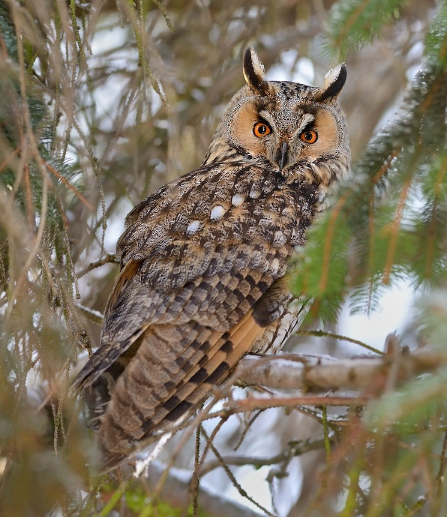Birdfinding.info ⇒ Across both Eurasia and North America, the Long-eared Owl is widespread and numerous overall, but secretive and difficult to find except at winter roosts. Both forms typically roost socially in dense stands of trees near open fields. The “Eurasian” form is especially common in Serbia and neighboring countries, where many towns have traditional roosting sites with flocks that regularly number in the dozens, and occasionally in the hundreds. Most winter roosting sites of the “American” form are kept secret due to concern for the impact of repeated disturbance.
Long-eared Owl
Asio otus
Temperate woodlands of Eurasia and North America. Comprises two distinct forms which may be more appropriately classified as separate species: the “Eurasian Long-eared Owl” (otus) and the “American Long-eared Owl” (wilsonianus).
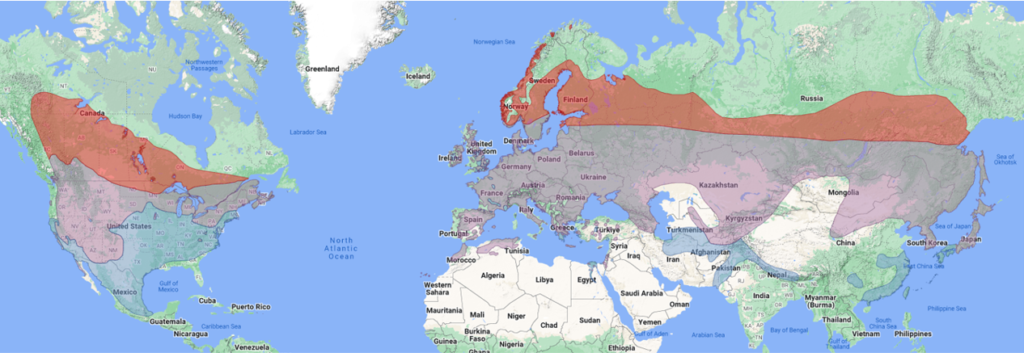
Approximate distribution of the Long-eared Owl. © Xeno-Canto 2023
Breeding. Nests in various kinds of woodlands and semi-open habitats, usually in dense forest or thickets that are near open meadows.
The Eurasian form breeds nearly throughout Europe, north to the treeline in Scandinavia and south to northern Morocco, Algeria, and Israel. Also on the Azores (all except Flores), the Canary Islands (throughout), and many of the larger Mediterranean islands.
In Asia, it breeds in most of the taiga belt from northwestern Russia east to Yakutsk, and south mainly in mountains to western and northeastern Iran, northern Afghanistan, northern India (to Himachal Pradesh), and northern China. Also on Sakhalin, Hokkaido, and northern Honshu.

The Canary Island population of Long-eared Owl is classified as a separate subspecies, A. o. canariensis. (Costa Teguise, Lanzarote, Canary Islands, Spain; January 17, 2022.) © Aitor Gil Guruceaga
The American form breeds over a large portion of Canada and the western and northeastern U.S. In the west it breeds from the southern Yukon and Northwest Territories south through most of the western U.S. from the Rocky Mountains to the Pacific coast, and south to northern Mexico—where there are summer records from northern Baja California, Chihuahua, and Nuevo León. In the east, it breeds from central Manitoba, northern Ontario, south-central Quebec, and the southern Maritimes south to Colorado, Nebraska, the northern Great Lakes, and in the northeastern U.S. south to West Virginia.
Nonbreeding. Northerly breeding populations of Scandinavia and the taiga of Eurasia and Canada withdraw to milder climates for the winter, and most other populations move locally. The favored habitat shifts away from forests toward semi-open land, including agricultural and urban areas. Remarkably sociable on wintering grounds, typically roosting in flocks—usually from the single digits up to twenty or so, but roosts numbering in the hundreds have been reported, mainly in central Europe.
The Eurasian form winters from southern Scandinavia, western Russia, Kazakhstan, Mongolia, Heilongjiang, and Honshu south to the Mediterranean region, Kuwait, Rajasthan, the southern Himalayas, central China (south to Sichuan, Hubei, and Zhejiang), South Korea, and Kyushu; and irregularly south to Egypt, the U.A.E., southern Pakistan, Gujarat, southern China, Taiwan, and the Ryukyu Islands.
The American form’s winter range overlaps widely with its breeding range, but excludes most of Canada. The northern edge extends from southern British Columbia east through Montana, South Dakota, and the Great Lakes to the St. Lawrence Valley of Quebec. There are scattered winter records north to southeastern Alaska, the central Prairie Provinces, and Newfoundland.
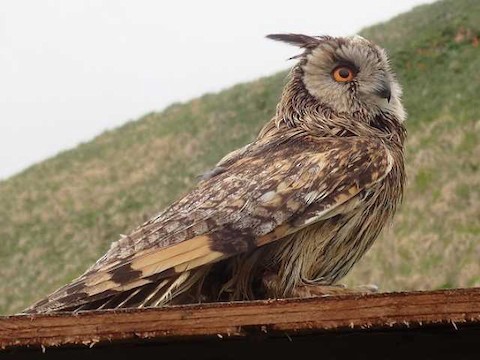
One of the two Alaskan records of “Eurasian Long-eared Owl”, A. o. otus. (Buldir Island, Alaska; June 8, 2016.) © Mackenzie Mudge
In the west, a small portion of the population moves south into Mexico, where roosting flocks have been found as far south as Durango and scattered individuals have been found recently south to Puerto Vallarta, Guadalajara, northern Michoacán, Mexico City, and southern Veracruz.
East of the Great Plains, it winters regularly south to the Ohio River Valley and Chesapeake Bay area, rarely south to Arkansas, Tennessee, and North Carolina, and exceptionally south to Florida.
Movements. The Eurasian form is occasional as a spring and fall vagrant west to the Faeroes and Iceland. Exceptional vagrants have been reported from Madeira, Western Sahara, southern Egypt, the Red Sea coast of Saudi Arabia, and Oman. It has been recorded twice in western Alaska: once on a boat in the northern Bering Sea; and the other on Buldir Island (June 8, 2016).
The American form is occasional as a fall and winter vagrant offshore to Isla Guadalupe (west of Baja California) and Bermuda. There are historical records south to Guerrero, Oaxaca, and Cuba.
Identification
A medium-sized owl that usually appears proportionately thin, long-bodied, and long-winged. Its prominent ear-tufts are close-set, directly above its eyes, and are often raised in alarm. Mostly nocturnal, but sometimes active around dusk—the most northerly breeding populations are inevitably active during daylight hours in summer.
The “Eurasian” and “American” forms are similar in most respects, but are usually distinguishable based on their overall coloration and plumage patterns. Their appropriate taxonomic status as distinct forms or possibly as separate species is uncertain.
Neither form has ever been recorded in the other form’s range, so identification by location is generally sufficient. However, both forms are migratory and both have been recorded in Alaska and on remote North Atlantic islands, so they may overlap from time to time.
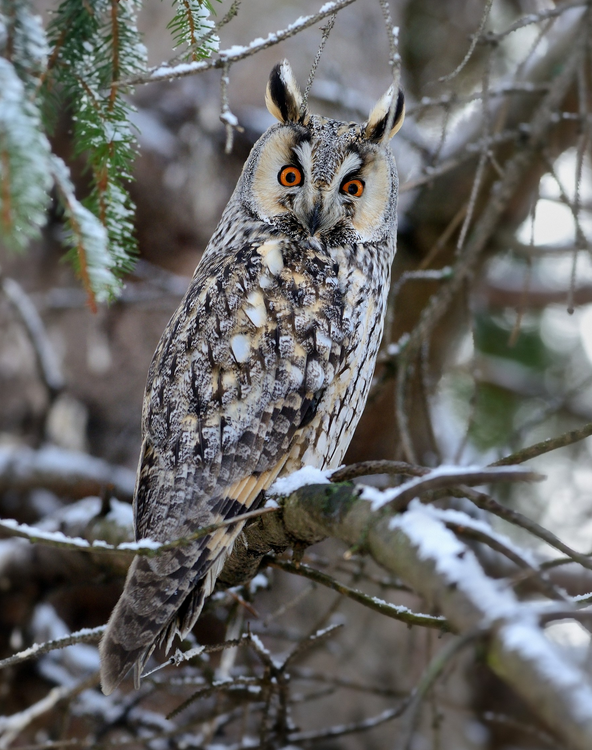
“Eurasian Long-eared Owl”, A. o. otus. (Velké Bílovice, Jihomoravský Kraj, Czechia; January 20, 2018.) © Pavel Štěpánek
The most definitive difference is eye color. The American form almost always shows pale- or bright-yellow irises, whereas the Eurasian form’s irises almost always appear orange—but can vary from yellow to red.
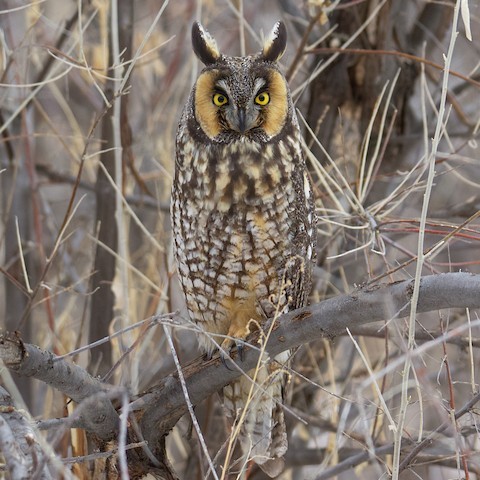
“American Long-eared Owl”, A. o. wilsonianus, showing a typically rusty facial disk and bright-yellow eyes. (Arapahoe County, Colorado.) © Dave Prentice
Their typical plumages also differ, most noticeably on the underparts. Both forms have mostly brown, cryptically patterned upperparts.
The Eurasian form is typically paler, grayer, and more uniform overall, with less heavily marked underparts—the markings on the belly typically appear as streaks without strong cross-barring.

“Eurasian Long-eared Owl”, A. o. otus, showing typically streaked underparts with weak cross-barring. (Novara, Italy; December 2, 2018.) © Luigi Andena
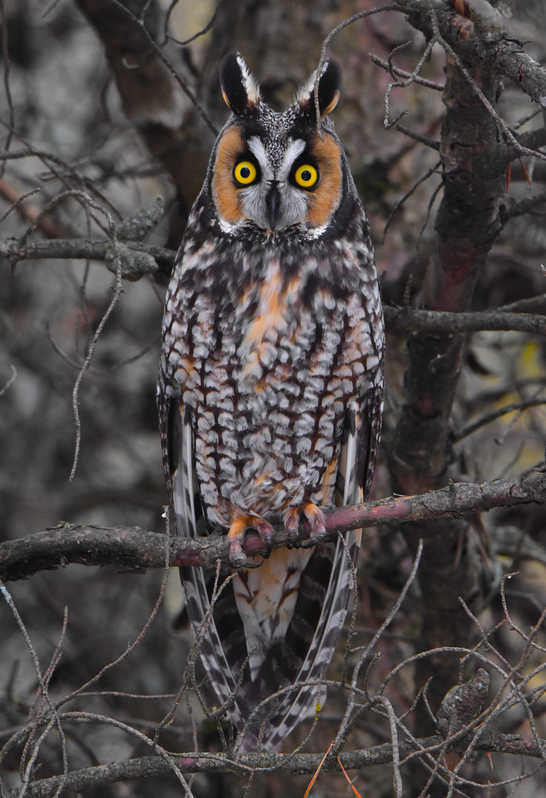
“American Long-eared Owl”, A. o. wilsonianus, a boldly-patterned, richly-colored individual. (Black Hawk County, Iowa.) © Dean Hester
The American form is typically darker and more contrasty overall, usually with much more heavily marked underparts—the markings on the belly show strong, blackish streaks and cross-barring.
However, both forms are highly variable and the darkest Eurasian birds show coloration and markings that would be typical of the American form. Likewise, pale American birds can show coloration typical of the Eurasian form, though usually with stronger cross-barring on the belly.
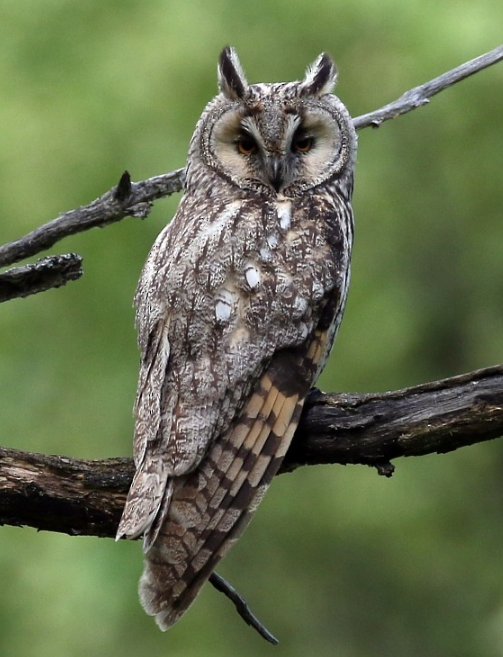
“Eurasian Long-eared Owl”, A. o. otus, a pale individual with a pale-gray facial disk. (Maloyaroslavets, Kaluga Oblast, Russia; July 11, 2015.) © Pavel Parkhaev
The Eurasian form’s facial disk is relatively pale, usually buffy or tan, but sometimes gray (or even whitish) and sometimes orangish—exceptionally rufous or chestnut. The American form’s facial disk is usually rufous or chestnut, but sometimes buffy or grayish.
Facial appearance varies significantly depending on alertness and posture. When encountered in daytime, it is typically seen in its resting posture, appearing tall and thin overall, with the facial disk narrowed and creased vertically and the ear-tufts raised vertically.
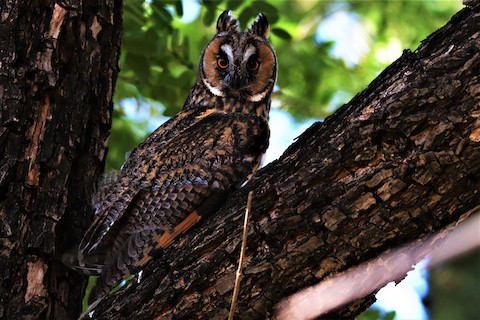
“Eurasian Long-eared Owl”, A. o. otus, an exceptionally dark individual with a rufous facial disk—much more typical of the American form—but note the orange eyes. (Hazor’im Reservoir, HaZafon, Israel; August 9, 2023.) © חיים ששון
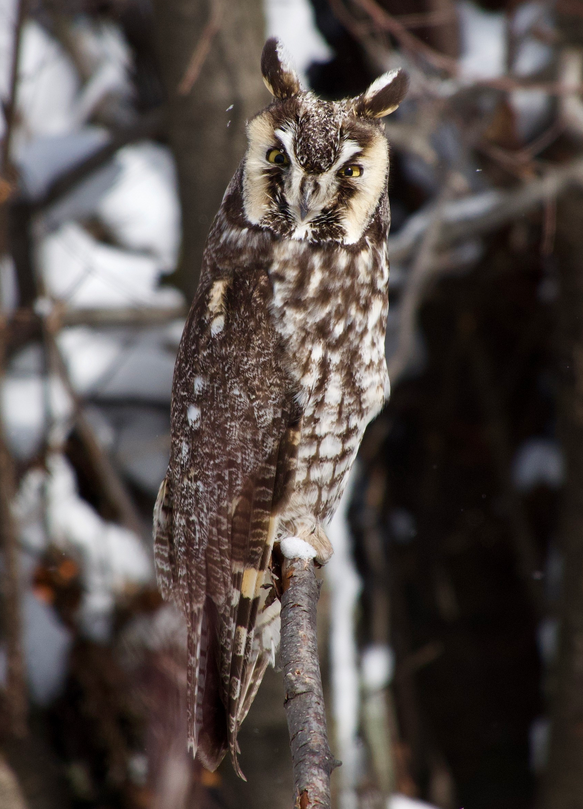
“American Long-eared Owl”, A. o. tuftsi, showing a whitish facial disk, more typical of the Eurasian form—but note the pale-yellow eyes. (Cariboo, British Columbia.) © Leslie Harris Jr.
When alert and active, especially when hunting, it opens its facial disk to a more circular shape and raises feather rows around the rim—which presumably enhances its ability to locate prey by sound—often showing a bright-white border. In this posture, the ear-tufts may either be raised or lowered. (When the ear-tufts are lowered, confusion with the Short-eared Owl is sometimes possible.)
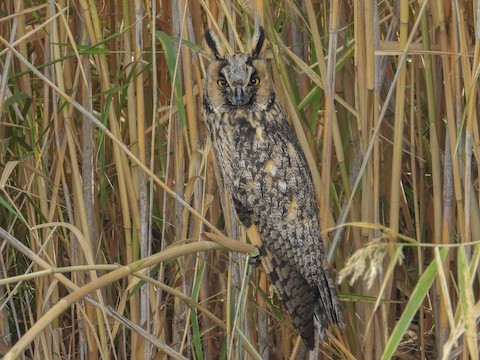
“Eurasian Long-eared Owl”, A. o. otus, with ear-tufts raised and facial disk narrowed. (Vila Franca de Xira, Portugal; October 9, 2022.) © Marcio Cachapela
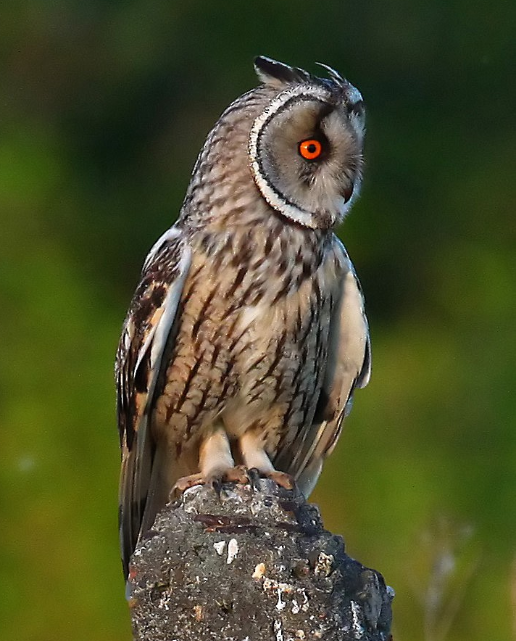
“Eurasian Long-eared Owl”, A. o. otus, with ear-tufts lowered and facial disk open and alert, showing exceptionally vivid orange eyes. (Michurinets Like, Moscow, Russia; May 24, 2011.) © Vladimir Duryabin
When seen flight, it can appear remarkably similar to a Short-eared Owl. The upperside of the wing appears mostly brown with darker bands and a prominent buffy patch in the primaries.

“Eurasian Long-eared Owl”, A. o. otus, dorsal view in flight, showing buffy patch at the base of the primaries. (Puerto del Musel, Gijón, Asturias, Spain; October 31, 2016.) © Daniel López-Velasco / Ornis Birding Expeditions
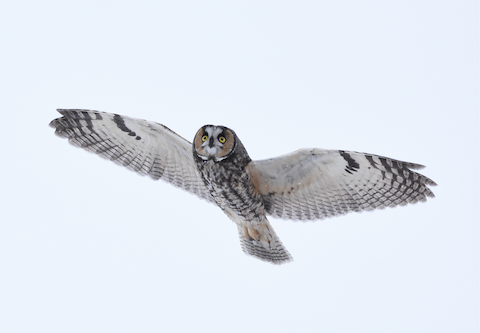
“American Long-eared Owl”, A. o. tuftsi, ventral view in flight. (Walla Walla, Washington.) © Christopher Lindsey
The underside of the wing is mostly pale with a prominent black crescent at the base of the primaries, and two or three distinct dark bars on the outer primaries.
Voice. The male’s advertising song is a low single whoo—among the most archetypal owl calls—given at regular intervals of approximately 1 to 3 seconds:
The American form’s typical song is somewhat higher-pitched than the Eurasian’s, more emphatic, with a slight rise and fall in each hoot:
Sometimes builds in intensity:Sometimes the American’s hoots are weaker, less emphatic, and can be fairly similar to Eurasian:Sometimes they are much more strongly voiced:Females’ calls are more nasal and higher-pitched, variably spaced at longer intervals (about 5 to 20 seconds), and usually given in response to the male’s song:Sometimes resembling a kazoo:Alarm calls of the Eurasian form include various types of barks, often in short bursts, that can be harsh:Or sharp:Or raspy:Or mellow:Or nasal:Or high-pitched:Juvenile begging calls are shrill whistles:The typical alarm call of the American form is a bark, often in short bursts, and the juvenile’s begging call is a shrill whistle—both heard in the following recordings:(For a detailed review of the Eurasian form’s vocalizations, with more recordings and sonograms, see The Sound Approach: Long-eared Owl.)
Notes
Polytypic species consisting of four recognized subspecies that are divided into two distinct forms which may be more appropriate classified as separate species: the “Eurasian Long-eared Owl” (otus) and the “American Long-eared Owl” (wilsonianus).
More Images of the Long-eared Owl
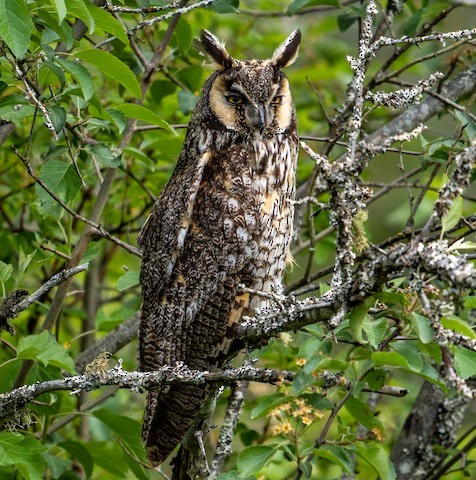
“American Long-eared Owl”, A. o. tuftsi, with atypically buffy facial disk, and showing cryptically patterned upperparts. (Squamish, British Columbia; June 6, 2022.) © Tiffany Brunke

“American Long-eared Owl”, A. o. tuftsi, appearing atypically robust—comparable to a Great Horned Owl—due to its hunched posture. (Vancouver, British Columbia.) © Joshua Glant
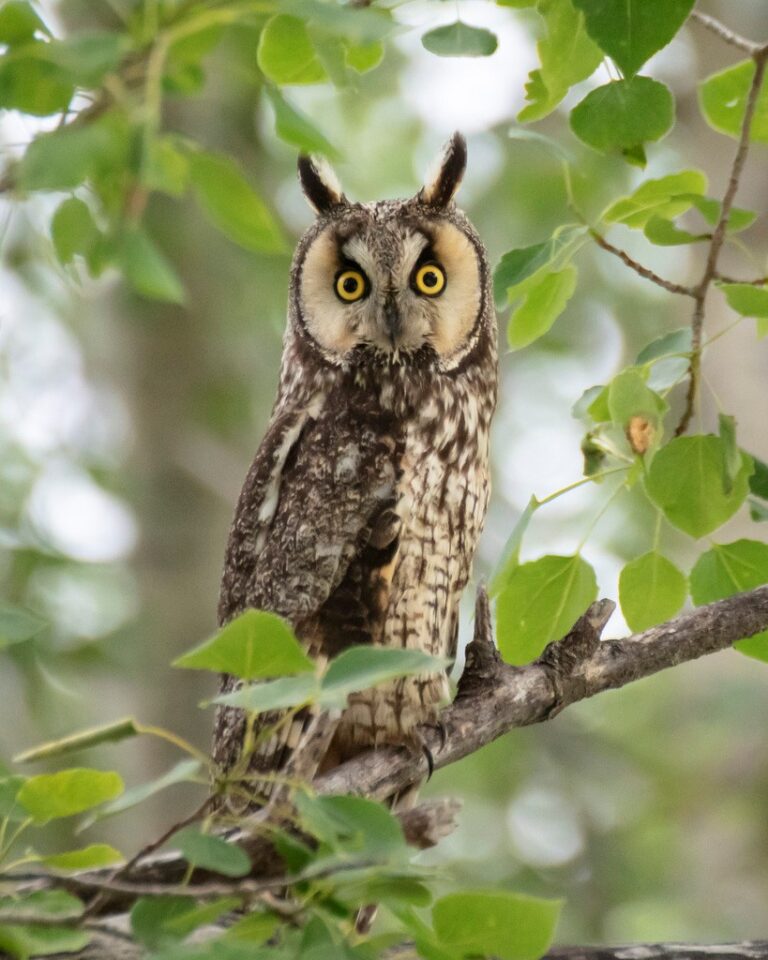
“American Long-eared Owl”, A. o. wilsonianus. (Clanwilliam, Manitoba; July 10, 2022.) © Karl Kroeker
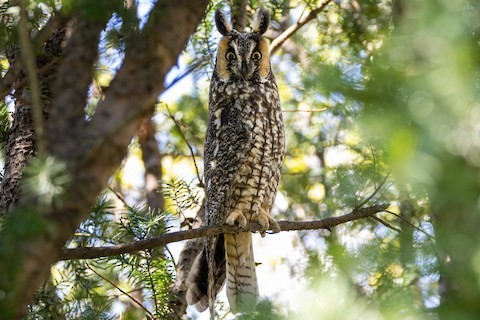
“American Long-eared Owl”, A. o. wilsonianus, appearing relatively tall and thin due to its alert posture. (Cuyahoga County, Ohio.) © Toby Carlstrom
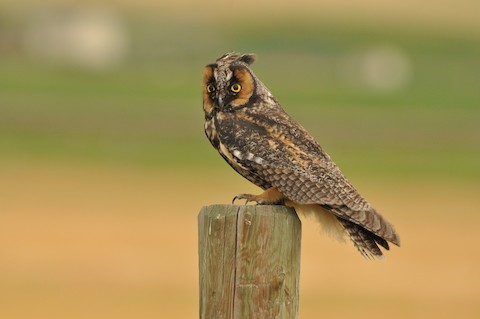
“American Long-eared Owl”, A. o. tuftsi. (Cache County, Utah.) © Ryan O’Donnell
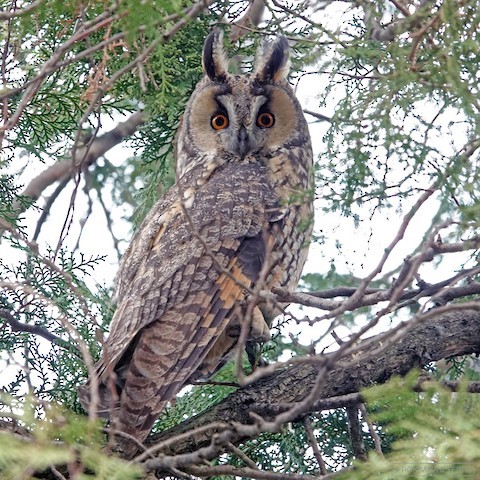
“Eurasian Long-eared Owl”, A. o. otus. (Opovo, Vojvodina, Serbia; November 25, 2018.) © Roksana and Terry
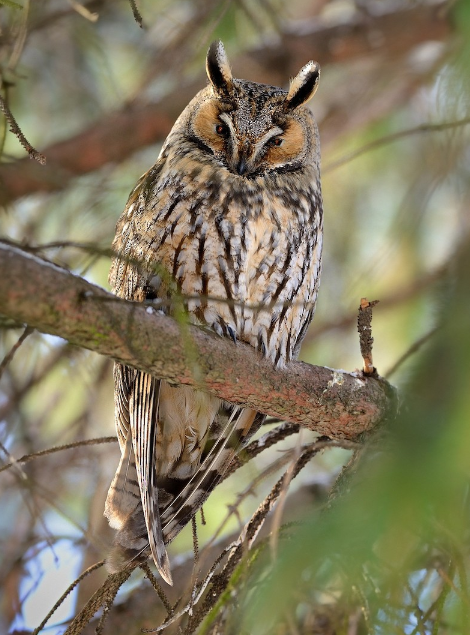
“Eurasian Long-eared Owl”, A. o. otus, showing typically streaked underparts. (Velké Bílovice, Jihomoravský Kraj, Czechia; January 20, 2018.) © Pavel Štěpánek
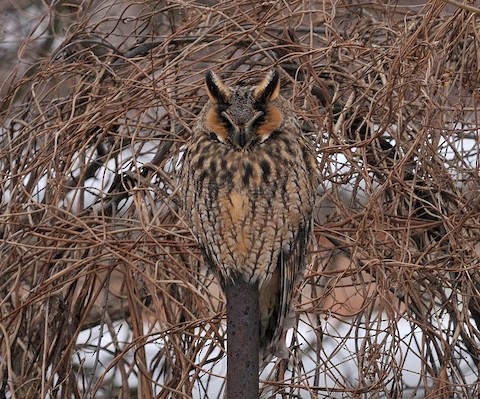
“Eurasian Long-eared Owl”, A. o. otus, a relatively dark and reddish individual, with overall coloration and pattern more typical of the American form, A. o. wilsonianus. (Drnholec, Jihomoravský Kraj, Czechia; February 6, 2010.) © Tomáš Grim
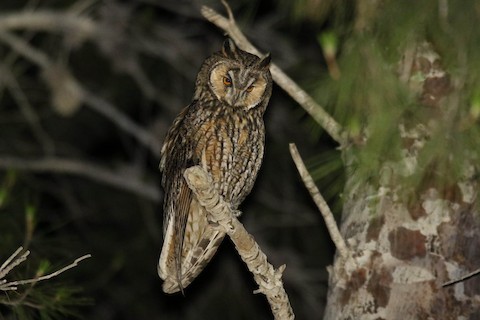
“Eurasian Long-eared Owl”, A. o. otus, a relatively dark individual with substantial cross-barring on the underparts. (Kibbutz Sde Boker, HaDarom, Israel; June 11, 2020.) © Amit Goldstein
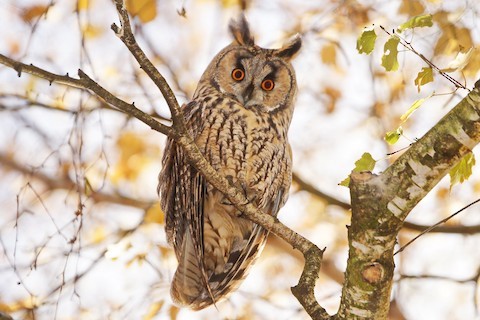
“Eurasian Long-eared Owl”, A. o. otus, showing typically streaked underparts. (Freiburg im Breisgau, Baden-Württemberg, Germany; November 18, 2017.) © Hieko Heerklotz
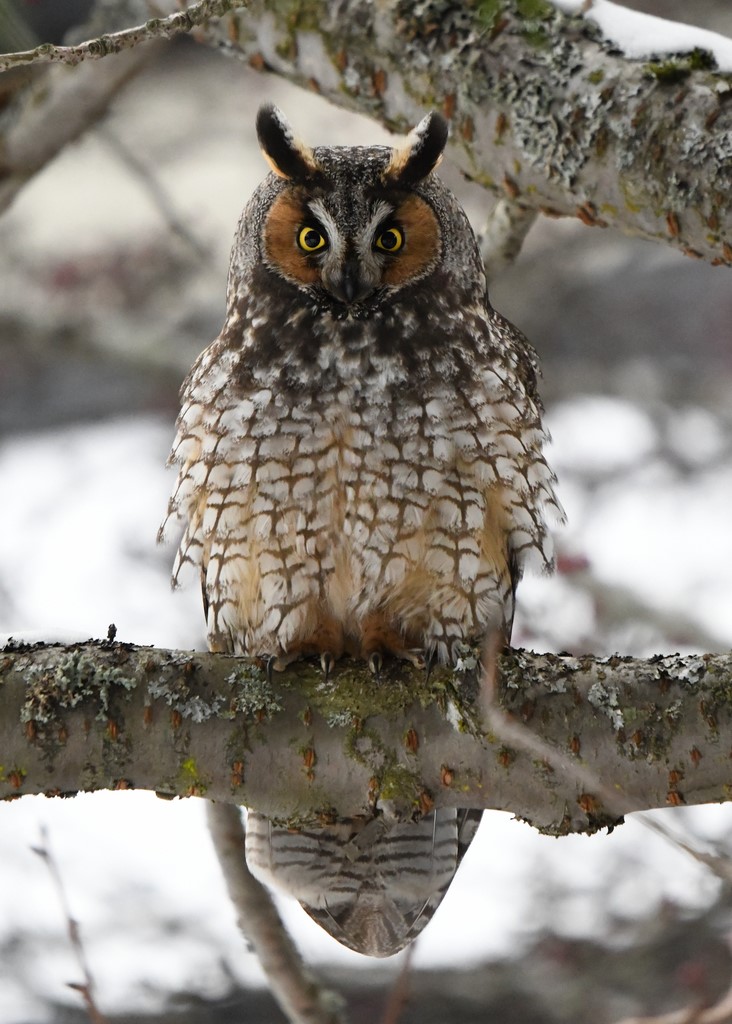
“American Long-eared Owl”, A. o. tuftsi, showing typically rusty facial disk and bright-yellow eyes. (Saanich, British Columbia; December 2021.) © Brian Starzomski
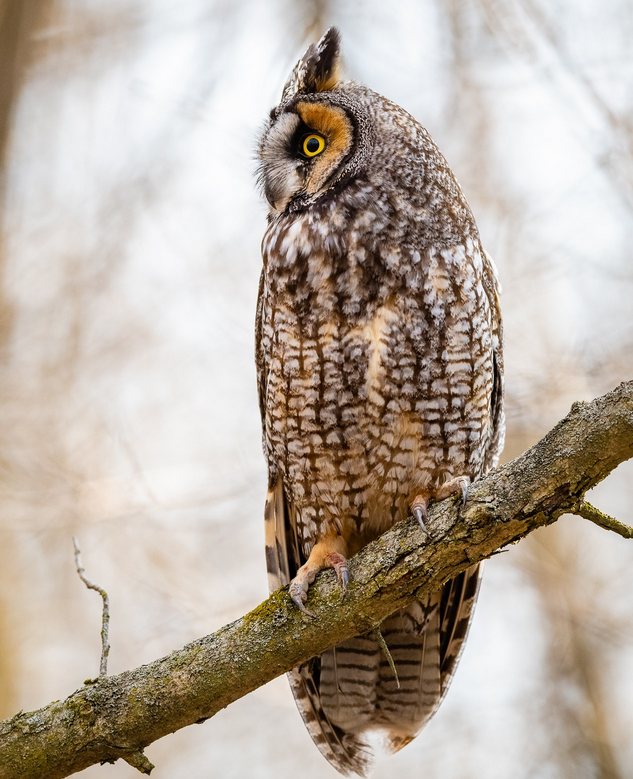
“American Long-eared Owl”, A. o. wilsonianus. (Lambton, Ontario; April 7, 2021.) © Roberta Buchanan
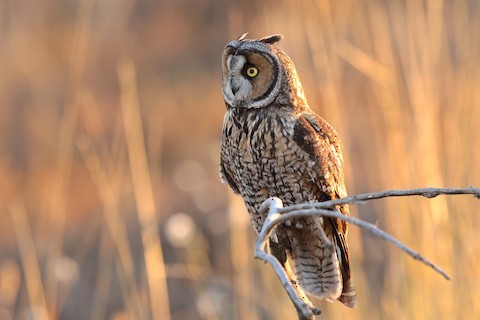
“American Long-eared Owl”, A. o. tuftsi, with its facial disk opened and ear-tufts partly flattened. (Alameda County, California.) © Aaron Maizlish
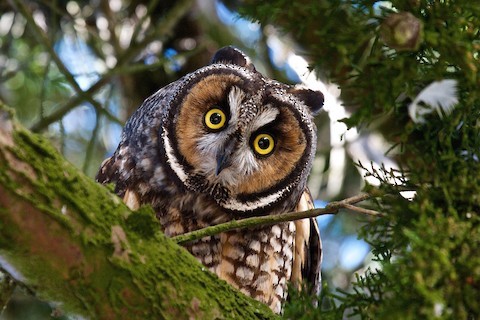
“American Long-eared Owl”, A. o. tuftsi, with its facial disk opened and ear-tufts partly flattened. (San Francisco, California.) © Matt Brady
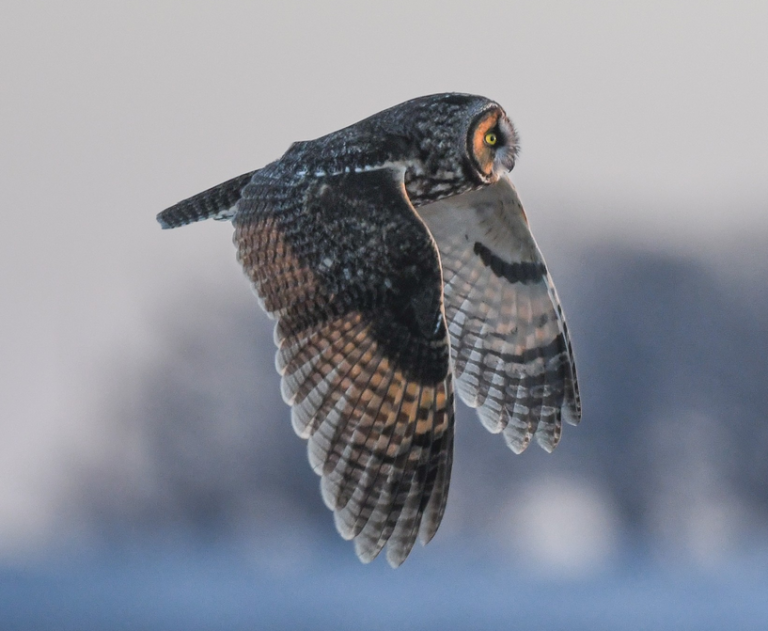
“American Long-eared Owl”, A. o. wilsonianus. (Steele County, Minnesota.) © Brendan Lanpher
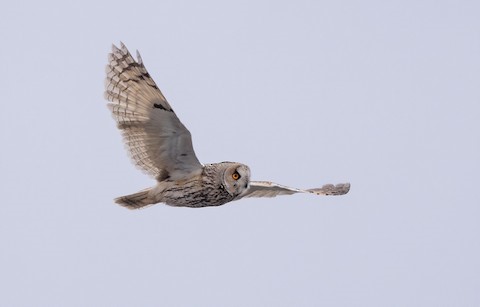
“Eurasian Long-eared Owl”, A. o. otus, showing pale underwing with a prominent black crescent at the base of the primaries, and three dark bars on the outer the primaries. (Söderskär, Emäsalo, Uusimaa, Finland; May 3, 2020.) © Matti Rekilä
References
Alderfer, J., and J.L. Dunn. 2021. National Geographic Complete Birds of North America (Third Edition). National Geographic Society, Washington, D.C.
BirdLife International. 2021. Asio otus. The IUCN Red List of Threatened Species 2021: e.T22689507A201150685. https://dx.doi.org/10.2305/IUCN.UK.2021-3.RLTS.T22689507A201150685.en. (Accessed October 17, 2023.)
Brazil, M. 2009. Birds of East Asia. Princeton University Press.
eBird. 2023. eBird: An online database of bird distribution and abundance. Cornell Lab of Ornithology, Ithaca, N.Y. http://www.ebird.org. (Accessed October 17, 2023.)
Garcia-del-Rey, E. 2011. Field Guide to the Birds of Macaronesia: Azores, Madeira, Canary Islands, Cape Verde. Lynx Editions, Barcelona.
Garcia-del-Rey, E. 2018. Birds of the Canary Islands. Christopher Helm, London.
Hollom, P.A.D., R.F. Porter, S. Christensen, and I. Willis. 1988. Birds of the Middle East and North Africa. T & AD Poyser, Calton, England.
Howell, S.N.G., and S. Webb. 1995. A Guide to the Birds of Mexico and Northern Central America. Oxford University Press.
iNaturalist. 2023. https://www.inaturalist.org/. (Accessed October 17, 2023.)
Kirwan, G.M., A. Levesque, M. Oberle, and C.J. Sharpe. 2019. Birds of the West Indies. Lynx Edicions, Barcelona.
König, C., and F. Weick. 2008. Owls of the World (Second Edition). Yale University Press.
Mikkola, H. 2012. Owls of the World: A Photographic Guide. Firefly Books, London.
Mullarney, K., L. Svensson, D. Zetterström, and P.J. Grant. 1999. Birds of Europe. Princeton University Press.
Owl Pages. 2023. Long-eared Owl ~ Asio otus. https://www.owlpages.com/owls/species.php?s=3550. (Accessed October 17, 2023.)
Salt, W.R., and J.R. Salt. 1976. The Birds of Alberta. Hurtig Publishers, Edmonton, Alberta.
Sibley, D.A. 2014. The Sibley Guide to Birds (Second Edition). Alfred A. Knopf. New York.
The Sound Approach. 2019. Long-eared Owl, Asio otus. https://soundapproach.co.uk/species/long-eared-owl/.
Xeno-Canto. 2023. Long-eared Owl – Asio otus. https://xeno-canto.org/species/Asio-otus. (Accessed October 17, 2023.)
